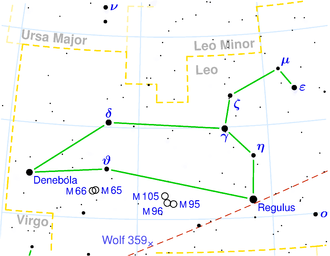NGC 3608
| Galaxy NGC 3608 |
|
|---|---|
![NGC 3608 [1] SDSS image](https://upload.wikimedia.org/wikipedia/commons/thumb/c/c5/NGC3608_-_SDSS_DR14.jpg/300px-NGC3608_-_SDSS_DR14.jpg)
|
|
| NGC 3608 SDSS image | |
| AladinLite | |
| Constellation | lion |
|
Position equinox : J2000.0 , epoch : J2000.0 |
|
| Right ascension | 11 h 16 m 58.951 s |
| declination | + 18 ° 08 ′ 55.26 ″ |
| Appearance | |
| Morphological type | E2 / LINER |
| Brightness (visual) | 10.7 mag |
| Brightness (B-band) | 11.7 mag |
| Angular expansion | 3.2 '× 2.6' |
| Position angle | 75 ° |
| Surface brightness | 13.1 mag / arcmin² |
| Physical data | |
| Affiliation | NGC 3607 group NGC 3626 group NGC 3686 group LGG 237 |
| Redshift | 0.004089 ± 0.000017 |
| Radial velocity | 1226 ± 5 km / s |
|
Stroke distance v rad / H 0 |
(52 ± 4) · 10 6 ly (15.9 ± 1.1) Mpc |
| history | |
| discovery | William Herschel |
| Discovery date | March 14, 1784 |
| Catalog names | |
| NGC 3608 • UGC 6299 • PGC 34433 • CGCG 096-022 • MCG + 03-29-022 • 2MASX J11165896 + 1808547 • GC 2359 • H II 51 • h 846 • GALEX ASC J111658.93 + 180855.6 • LDCE 778 NED031 • HOLM 240B | |
NGC 3608 is an elliptical galaxy with an active nucleus of the Hubble type E2 in the constellation Leo on the ecliptic . It is estimated to be 52 million light years from the Milky Way and about 50,000 light years across. Together with NGC 3605 and NGC 3607 , it forms the galaxy trio Holm 240 . Together with eleven other galaxies, it is considered a member of the NGC 3686 group ( LGG 237 ).
The object was discovered by Wilhelm Herschel on March 14, 1784 .
Web links
Commons : NGC 3608 - collection of images, videos, and audio files
